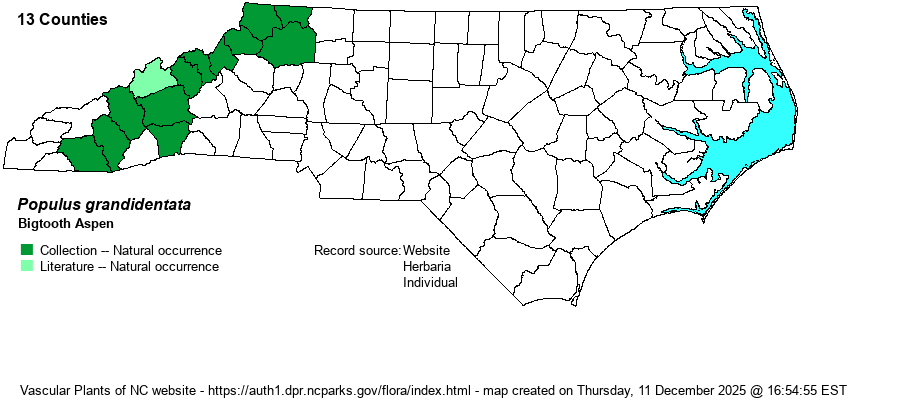| Author | Michaux | |
| Distribution | Restricted to the Mountains, found in the majority of counties from the VA border to those along the SC/GA border, except seemingly absent in the far southwestern counties.
This is a Northern species ranging south widely in VA, but farther south only in the Mountains in NC and SC. Ranges more widely in TN and west to the Great Plains states.
| |
| Abundance | Rare to very uncommon, and spotty in its montane range. This is an NC Watch List species. | |
| Habitat | Unlike our other two native cottonwoods, this Populus is restricted to dry and often rocky forested slopes, shrub balds, upland thickets and borders, etc. It is not found in moist or wet habitats. |
| Phenology | Flowers and fruits in April and May. | |
| Identification | This is a medium-sized deciduous tree growing to about 60 feet tall. It has quite distinctive leaves among our native trees, with leaves being widely ovate to rotund and strongly toothed, with a slightly rounded base; they often reach 4 inches long and nearly as wide. Other native Populus do not grow in upland sites in the mountains, and the leaves are much less toothed. The exotic White Poplar (Populus alba) can have leaves somewhat resembling this species, but the leaves are thick and are very white below, easily noted from afar; most individuals of White Poplar are found in open, man-influenced sites. Bigtooth Aspen is scarce enough that you probably will not encounter it on your own, unless you visit a known site. | |
| Taxonomic Comments | None
| |
| Other Common Name(s) | Largetooth Aspen, Bigtooth Poplar. Note that the genus Populus includes species commonly named as aspens, poplars, and cottonwoods. | |
| State Rank | S2 | |
| Global Rank | G5 | |
| State Status | W7 [W1] | |
| US Status | | |
| USACE-agcp | FACU link |
| USACE-emp | FACU link |

